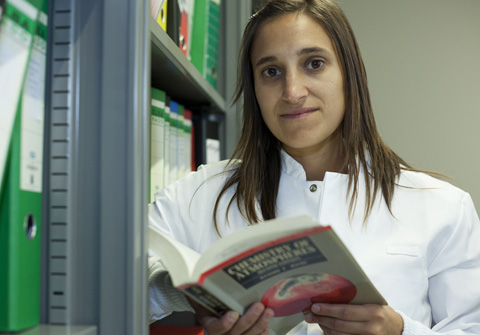The UPV/EHU's Atmospheric Research Group (GIA) has focussed one of its lines of research on carbon tetrachloride (CCl4), an ozone layer depleting substance which may be carcinogenic for humans and a cause of the greenhouse effect. The study is based on measurements recorded continuously over the years at Valderejo and Bilbao. Among the conclusions arrived at, the researchers highlight that there is evidence of unidentified emissions of this gas despite the restrictions established by the Montreal Protocol.
Evidence of unidentified emissions of a chlorine gas despite restrictions on its use
The UPV/EHU-University of the Basque Country has carried out a study in Bilbao and Valderejo to see whether there are any existing sources of carbon tetrachloride gas (CCl4) and what the long-term trend of this compound is
First publication date: 20/09/2016

Carbon tetrachloride (CCl4) is a colourless, sweet-smelling, non-flammable liquid with low water solubility that evaporates easily, so it is routinely found in a gaseous state in the air. It is one of the substances that depletes the ozone layer, may have adverse effects on health (a possible carcinogen for humans) and is a greenhouse gas. CCl4 concentrations in the ambient air have been studied exhaustively, in particular after it was included in the list of substances in the Montreal Protocol, which came into effect in 1989 with the main aim of protecting the ozone layer.
Naturally occurring emissions of CCl4 (seaweed, plants, oceans and volcanos) may be regarded as negligible compared with artificial emissions (anthropogenic ones). Right now, despite restrictions on its use, there is evidence of unidentified sources of CCl4, which could come from industry, polluted locations and toxic waste treatment plants, among other things. Most of the CCl4 measurements were recorded in remote areas far from industrial and urban centres to find out what its long-term trend is. The results point to a fall in the concentration of CCl4 in the ambient air, although not as sharp as expected.
According to Maite de Blas, a researcher in the UPV/EHU's Atmospheric Research Group (GIA), "in order to detect potential sources of CCl4, measurements were recorded at the Faculty of Engineering in Bilbao, located in a urban area affected by the surrounding industry, over a one-year period (March 2007-February 2008)", and to do this they used a system based on gas chromatography coupled to a mass spectrometry device (GC-MSD). At the same time, they used the measurements of volatile organic compounds carried out —by means of gas chromatography with flame ionization detector (GC-FID)— at the Valderejo Nature Reserve over a period of five non-consecutive years (January 2003-December 2005, June 2010-June 2011 and June 2014-July 2015); here, CCl4 was not specifically measured but a method was developed to retrieve results using stored data. As the location is a rural area far from large urban and industrial centres, it offered the best characteristics for analysing the long-term trends of this compound.
The average CCl4 concentration values measured in Bilbao were slightly higher than those measured at Valderejo, the latter being higher than those at other remote stations in the Northern Hemisphere. Yet in Bilbao peaks in CCl4 were recorded owing to the existence of sources close to the measuring point. "Part of the emissions may be due to evaporation although this is not the only source, since it was confirmed that an increase in temperature did not always mean an increase in the concentration of CCl4,"explained Maite de Blas. Despite the restrictions imposed by the Montreal Protocol, the analytical use of CCl4 in laboratories is allowed, so some emissions could be associated with the use of CCl4 in the teaching and research labs themselves.
Various unknowns to be resolved
An analysis carried out in Bilbao taking wind direction and speed into consideration indicated the existence of one or several potential sources of CCl4 in a south-westerly direction. During 2007 and 2008 a factory of halogen products was found operating at a location in that direction with respect to the measuring point. However, the only industrial activity in the area that officially reported CCl4 emissions during the period measured was an urban waste disposal plant. "To clarify the origin of CCl4 in Bilbao, an exhaustive study of emissions from other potential sources nearby would need to be conducted," said the researcher, "such as the waste incineration plant, marine sources and the oil refinery".
The time series of CCl4 concentration obtained at Valderejo indicated that there are no significant sources nearby. What is more, the arrival of polluted masses of air containing benzene and toluene, among other things, do not constitute an increase in CCl4 concentrations. The long-term trend of the CCl4 at Valderejo is not clear: a fall was seen from 2003 to 2004 and from 2004 to 2005 and there was a slight increase in 2010; these results coincide with the estimate of emissions made by the World Meteorological Organisation and published in the report Scientific Assessment of Ozone Depletion: 2014. "To explain the long-term trend of CCl4 at Valderejo," she concluded, "the aim is to complete the time series with the results of the CCl4 measurements that are currently continuing to be made".
Additional information
The Atmospheric Research Group (GIA) is a consolidated, inter-departmental group made up of researchers in the UPV/EHU Department of Chemical Engineering and the Environment, and the Department of Applied Mathematics, whose lead researcher is the UPV/EHU professor Lucio Alonso. One of the GIA's lines of research focussing on the study of volatile organic compounds (VOCs) in the ambient air dates back more than 20 years.
The description of the potential sources of CCl4, and also the method developed to retrieve the results using stored data have been set out in the paper published by the group's members in the journal Science of The Total Environment.
Photo: Marino Navazo. UPV/EHU.
Bibliographic reference
- Atmospheric carbon tetrachloride in rural background and industry surrounded urban areas in Northern Iberian Peninsula: Mixing ratios, trends, and potential sources
- Science of the Total Environment (2016)
- DOI: 10.1016/j.scitotenv.2016.03.177

